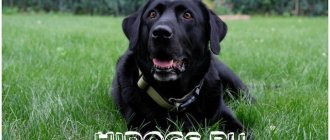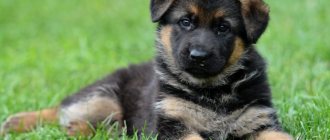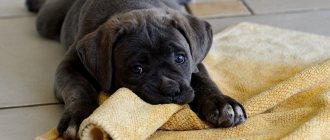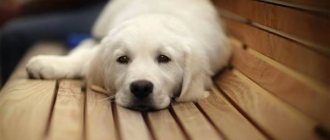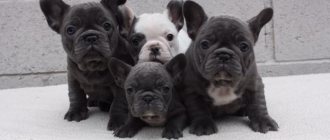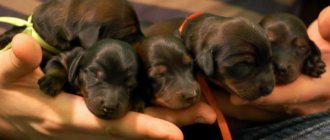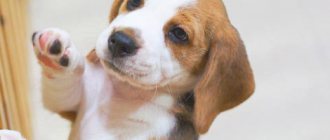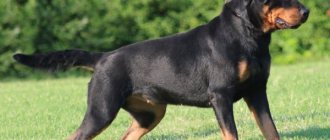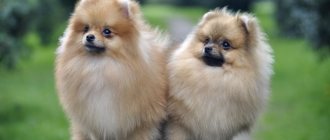What does a 3 month old puppy look like in the photo?
A healthy puppy looks well-fed, and there is no excess weight . The wool is particularly smooth and has a natural shine. The paws are strong and dense.
The molars erupt to replace the milk teeth . Provide your baby with safe chew toys to help relieve toothache.
Features of the first days of life
Preparation for proper puppy care should begin even before the baby arrives.
- Decide in advance where the pet will be located in the house. There should be no drafts, sharp corners or crevices nearby where the pet can crawl.
- Put away small items, jewelry, and medications that your baby might swallow.
- If the house has laminate or parquet, it is advisable to cover the floor with a carpet or runner at first.
- Immediately buy everything you need to care for your little Labrador: vitamins, food, brushes, toys, dishes, a collar with a leash, etc.
Like all puppies, Labradors are born blind, helpless, unable to independently regulate their body temperature and eliminate waste products.
Important! At these times, their mother is completely responsible for the life of the baby: she not only feeds, but also warms, and also stimulates the work of the small intestines with her caresses.
The first two weeks of a baby's life consists of 90% sleep and frequent meals. Their sleep is very active: the puppy twitches at times, moves its limbs, and may whine. This occurs during muscle growth, so it is absolutely normal for this age.
Learn how to care for Dachshund, Chihuahua, and German Shepherd puppies.
At this stage of the Labrador’s life, nothing special is required from the owner, except to provide comfortable conditions for the baby and his mother. However, be careful: periodically, the female, turning in her sleep, can crush the puppy and not notice it. Therefore, when you hear a squeak, it is better to come and make sure that everything is in order, and, if necessary, help the baby.
Dog character
In the third month, behavioral characteristics can be compared with those of teenagers. He considers his family to be his pack, studies the internal hierarchy and tries to determine his place.
The puppy becomes more independent and tries to show dominance . You may notice how he questions power and authority.
The puppy may chew on the stick and ignore commands, but his attention is focused on your reaction. Be steadfast, tolerant and gentle. Your actions must be consistent, and your commands must be reinforced.
If your puppy bites or growls while playing, stop the inappropriate behavior and ignore it for a few minutes..
Do not fight with the puppy under any circumstances. This will make it clear that the fight is good and fun. Your main task is to instill in the dog the concept of obedience.
If the puppy becomes overexcited and aggressive, stop interacting immediately..
From 6 to 18 months - young dog
Starting at 6 months, your puppy is already in the final stages of his development, but he is still very young. At this time, the puppy will be full of energy and will continue to explore the world around him.
It's important to remember that your buddy is still a puppy, even though he looks like an adult dog. You can start working on advanced levels of training, or continue training him to interact in a non-aggressive manner with other animals and people.
It is also likely that your dog will go through another "fear" stage after reaching 6 months. Not all Labradors experience this stage again, but if it does, you know what to do.
Photo of Labrador 1 year:
What is better – natural or dry food?
The puppy needs to be fed the food he is accustomed to from the breeder. Gradually add new foods and adapt the animal to a food system that is convenient for you.
A sudden switch to another food can cause food refusal.
At three months it is recommended to adhere to a balanced natural diet, and to resort to dry food only in rare cases when it is not possible to prepare nutritious food.
If you decide to completely switch your pet to dry food, then natural products must be excluded.
Specially formulated premium dry food contains all the necessary nutrients for the proper development of the puppy, and the presence of secondary food will upset the balance of nutrients.
This can cause liver and kidney diseases . Occasionally treat your puppy with fresh fruits and vegetables as treats.
Expert opinion
Kozhevin Semyon Kirillovich
Expert dog handler.
I recommend creating an individual balanced diet for your puppy from natural products. In the first half of the day, give milk and vegetable mixtures, and in the second - meat and canned food. Consider your pet's activity and food preferences. There is no need to force your dog to eat something it doesn't like.
How to choose your future pet?
Choosing a Labrador puppy depends on personal preference. You can choose between a boy and a girl, color and character. It is necessary to observe the behavior of the puppy and its parents, make sure that the breed is pure and has a passport. You need to make sure that neither of the parents has or is sick with anything, as this could be passed on to the puppy.
IMPORTANT!
The most important thing when choosing a puppy is the realization that you are acquiring a new family member who needs affection and care. You will need to monitor his health, hygiene and mood, as well as educate him. In the future he will become the most devoted friend and protector.
Basic feeding rules
Labradors quickly get used to the schedule set by the owner, so they need to be fed at the same time, leaving the bowl of food for 15 minutes. If the pet does not eat or begins to play, the food is removed. This is how you teach your dog to be disciplined.
You shouldn’t walk around with a bowl and try to persuade someone to eat . Otherwise, you will have to beg an adult dog later. Access to fresh water should be available at all times.
A puppy needs 2-4 times more nutrients than an adult dog of the same size, since the growth process is accompanied by high energy costs .
Three-month-old dogs eat a large amount of food in relation to their total body weight, but their stomachs are still small and can only accommodate frequent small portions.
From 2 to 4 weeks - transitional stage
Puppies will begin to open their eyes and respond to nearby lights, sounds and movement. During this period, they will also begin to go to the toilet on their own and begin teething.
You will also notice that the puppies begin to move more and more. And although at first they will mostly crawl, they will soon begin to walk and even run. The puppy will also begin to recognize its siblings and mother during this time. At some point he may even try his mother's regular food, but he will still need his mother's milk
Photos of Labrador puppies 2 weeks:
Photos of Labrador puppies 3 weeks:
Natural food
The natural diet of a three-month-old Labrador includes products such as:
- milk;
- low-fat cottage cheese;
- minced meat and fish;
- porridge;
- vegetables;
- soft cartilage.
Prohibited Products:
- raw river fish;
- raw chicken meat;
- fried pork and beef;
- lung;
- sausages, sausages, hard bones;
- pearl barley, semolina, millet cereals;
- legumes (beans, peas);
- smoked, salted, pickled, spicy;
- sweets (chocolate, pastries, cakes).
In the daily diet, cereals make up 1/3 of the total volume, the rest comes from meat and dairy products. Prepare a fresh portion for each meal.
NOTE!
Do not serve food that is cold or too hot. Food should be at room temperature.
The puppy is fed 4 times a day.
The approximate feeding schedule looks like this:
- 7:00;
- 12:00;
- 17:00;
- 22:00.
Menu for the week
| Product group | Menu |
| Dairy | Goat's milk, cow's milk, low-fat cottage cheese, kefir. |
| Meat and fish products | Boiled chicken, beef, lamb, cod or pollock meatballs. |
| Porridge | Buckwheat, rice, wheat, crushed oatmeal. |
| Other products | Vegetables, fruits, herbs, egg yolk, soft veal bones and cartilage. |
How much to give?
The amount of food is individual and is calculated based on the weight and activity of the puppy.
Observe your pet's eating behavior. If after eating the dog greedily licks the empty bowl, it means the portion is not enough.
If the stomach looks bloated and tight, then the amount of food should be reduced . Labradors are prone to obesity, so don't overfeed your puppy with carbohydrates.
Average daily servings:
| Products | Weight |
| Meat | 350 gr |
| Cottage cheese | 100-150 gr |
| Porridge | 150 gr |
| Milk | 300 gr |
| Kefir | 300 gr |
Approximate daily diet
- Breakfast : low-fat cottage cheese 100g + kefir 1% 50 ml + 50 g porridge
- 2nd breakfast : 100 g of porridge + vegetables, 100 g of greens;
- Lunch : meat (fish, poultry) 120 g + vegetables, greens 100 g;
- Afternoon snack : low-fat cottage cheese 100 g + kefir 1% 100 ml;
- Dinner : meat 130 g + vegetables, greens 100 g, egg (1-2 r per week per week)
Vitamins and supplements
There is no consensus on an additional vitamin-mineral complex . The amount and type of supplements a puppy needs for normal development and functioning are prescribed by a veterinarian.
CAREFULLY!
It is not recommended to give calcium as it can cause problems with baby teeth falling out.
From 4 to 8 weeks (1-2 months) - socialization stage
Once the puppy reaches 4 weeks of age, he will begin to learn the most important things in his life related to social behavior. He will learn not to bite and interact with other dogs and animals.
Social interaction with people is especially important between the 5th and 8th weeks. During this time, the puppies will also learn discipline from their mother. She will begin to wean her puppies and teach them proper manners.
You can begin to gradually introduce regular food into your puppy's diet from about 4 weeks of age. Start with small amounts as the mother is still feeding them.
Make sure to exercise your puppy regularly every day. But do not separate him from his fellow dogs for more than 10 minutes, as this may lead to problems with socialization.
Dogs that have been separated from their mother and litter too early may be more nervous and bark and bite more often. Problems with further training and socialization can also often be attributed to puppies that are separated from their siblings too early.
Photos of Labrador puppies 1.5 months old:
Photos of Labrador puppies 2 months:
Feeding dry food
Dry food for a puppy is selected based on age and nutritional characteristics. Quite often, Labradors have an allergic reaction to components in the food.
This does not mean that the food is bad, just that it is not suitable for your pet . In such cases, it is necessary to contact a veterinarian, find out the cause of the allergy and choose the appropriate food.
How to choose?
Experts do not recommend choosing budget brands.
Economy class feeds contain insufficient nutrients, which means they will not be able to meet the needs of a growing organism . Cheap food is more likely to cause allergies.
Classic hypoallergenic foods are those consisting of lamb meat, rice, and sea fish. High-quality feeds are included in the “premium” class and higher.
You should pay attention to the amount of proteins in the composition . High protein intake is not recommended for Labradors.
Take a closer look at manufacturers such as:
- Acana;
- Orijen;
- GO;
- Now Fresh;
- Hill's;
- Purina Pro Plan.
Information on how many grams of dry food to give your puppy per day can be found on the packaging, taking into account the individual characteristics of your pet.
Cleaning teeth, ears and trimming nails
First, you need to carefully examine your ears and teeth for inflammation or infections.
To clean your ears, you can use cotton wool, gauze, cotton pads, cotton swabs or special wipes.
You can brush your teeth yourself by wrapping your finger in gauze or a bandage, or with a special brush. You can also use teeth cleaning products purchased at a pet store.
As for trimming claws, if the owner does not have sufficient experience, it is better to contact a specialist. In any case, you need to buy special tweezers for cutting.
Do I need to get vaccinated?
At 3 months, the puppy receives a mandatory vaccination against canine distemper, infectious hepatitis, parvovirus enteritis and canine parainfluenza: Nobivac DHPPi + Nobivac Lepto or Eurican DHPPI2-L.
10 days before vaccination, treatment against worms is required, and after vaccination the animal must be quarantined for 14 days.
Caring for a three month old puppy
Labradors, by their nature, are particularly clean, so they do not need any special care. The coat of these dogs is short and smooth.
You can comb it 2-3 times a week.
If the puppy rarely goes outside and does not spend much time there, then he should be bathed less often than an adult dog . After a walk, wipe their paws with a damp towel.
Nail trimming occurs as needed, and if the puppy spends most of its time outdoors, the claws will grind down on the asphalt.
The animal’s ears should be cleaned once a week with a cotton pad, and the eyes should be wiped with a damp swab in case of visible dirt..
How to bathe properly?
The next aspect, which is no less important when caring for a Labrador, is bathing. You should not bathe your pet often; do it only when absolutely necessary. Since the Labrador's coat repels water, it will be quite difficult to get your dog wet. You can bathe with or without shampoo.
Do not allow water or shampoo to get into your ears, eyes or mouth.
This breed loves to splash in the water, but they are not always able to endure the washing procedure.
Training and education
Labradors are easy to train. The behavior of the puppy directly depends on the owner - the leader of the pack, who dictates the rules. Punishment for an offense is accepted if it follows immediately after the action. Correct execution of the command is immediately rewarded.
The puppy is taught that the owner has the right to a toy and food . Any aggression towards a family member must be stopped.
Some time after sleeping, eating or playing, the puppy is taken outside, teaching him to relieve himself outside the house. Until the puppy has learned to control his body, scolding him for puddles is useless.
If you adhere to the rules, then gradually the dog will begin to ask to go outside on its own, for which you need to praise.
During a walk, immediately stop attempts to tug on the leash with a jerk and the command “near!”, and after a few meters the command “walk” is accompanied by freedom for the length of the leash.
At home, the puppy is taught not to bark for no reason, not to climb on the bed, and not to take food outside the bowl.
At 3 months, the puppy should know his name and master the following commands :
- "Ugh!";
- "Place!";
- "Lie!";
- "Sit";
- "Near!";
- "Go for a walk."
Every year there are more and more fans of Labradors all over the world.
The breed is particularly loyal, flexible, kind and trainable . These dogs have practically no negative qualities, while combining a huge number of advantages.
Puppy weight and height by month
During the first year of life, a tiny retriever puppy goes through the process of maturation. There are three stages:
- up to 4 months – rapid growth;
- 5-8 months - slow development;
- 9-12 months – slight increase.
After the expiration of the period, the adult dog is already suitable for participation in exhibitions.
It is extremely important that the general parameters - height and weight - meet the requirements of the officially approved standard. Deviations upward or downward are considered unacceptable and the individual is rejected.
Dogs are born weighing from 0.4 to 0.55 kg. Every day they gain 120 g in weight. During the first week of life, the baby gains about 1 kg. According to generally accepted standards, a baby Labrador grows rapidly in the first two months after birth. Its mass increases almost 2 times.
A month old Labrador reaches 3 kg and stretches approximately 23 cm in height. At 5 months of age, according to the rules, a puppy must have 2/3 of its standard weight. After 10 months, the dog’s parameters practically do not change. The one-year-old black retriever is fully grown.
To compare the indicators, special tables are used that show the height and weight of Labrador puppies on a monthly basis. However, in real life, the size of a pet may differ from the average. Each individual develops under the influence of many factors. Among them:
- diet;
- physical exercise;
- Lifestyle.
Table of Labrador development parameters (by month):
| Age, months | Weight, kg | Height at withers, cm | Chest circumference, cm | Head circumference, cm | Muzzle circumference, cm | Muzzle length, cm | Mouth circumference, cm |
| 1 | 3.4-3.8 | 23-23.5 | 37-38 | 27-28 | 17 | 3.5-4 | 9 |
| 2 | 7-8 | 30-32.5 | 45-56 | 29-32.5 | 20.5-22 | 4.5-5.5 | 10.5-11 |
| 3 | 12-14 | 39.5-42 | 51-56 | 34-36 | 23-24 | 6-7 | 11.5-11 |
| 4 | 17-19 | 44-46 | 60-64 | 38-39 | 24-26 | 7-8 | 11.5-12 |
| 5 | 21-22 | 48-51 | 66-68 | 41-42 | 25-27 | 7.5-8.5 | 11.5-12 |
| 6 | 24-26 | 50-55 | 67-70 | 42-43 | 27-28 | 7.5-9 | 11.5-12.5 |
| 7 | 26-28 | 52-56 | 69-74 | 43-44 | 28-29 | 7.5-9 | 11.5-13 |
| 8 | 28-30 | 54-57 | 70-76 | 45-46 | 28-30 | 7.5-9 | 11.5-13 |
| 9 | 29-32 | 54-58 | 70-77 | 46-48 | 28-31 | 7.5-9.5 | 11.5-13.5 |
| 10 | 30-36 | 54-58 | 70-84 | 46-55 | 28-32 | 7.5-10 | 11.5-14 |
| Adult | 30-40 | 54-58 | 70-86 | 46-56 | 28-32 | 7.5-10 | 11.5-14 |
